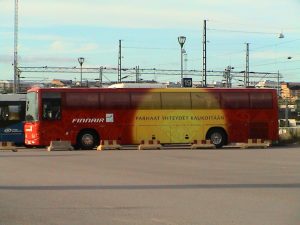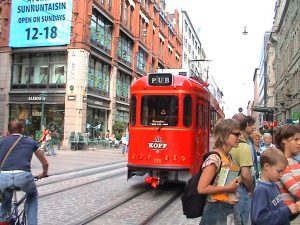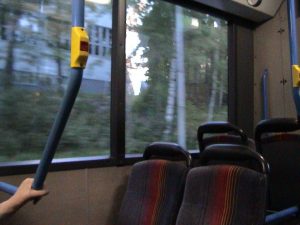Fire and Ice 15
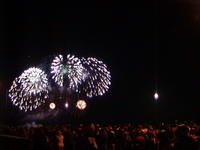 Island) barely touched Helsinki (but for a couple overshot shells), and the population even gathered on hills to watch the dramatic ‘fireworks’. This event refers to the bombing of Viapori, when the English and French navies bombed Suomenlinna (Viapori) while Finns watched on from the hills of Kaivopuisto Park. The best places for watching the Finnish Fireworks Championships are along the coasts of Kaivopuisto and Katajanokka, as well as the end of Hernesaari Island. The fireworks this year started at 10:30 pm, strategically timed with a full moon night. As I prepared to reach the venue I was ‘shell-shocked’ to see the crowd accumulated at the tram stop. For a place like Helsinki, that’s quite a sight. Suddenly there were too many ppl, more than the tram stop could accumulate, forget the tram itself. I realised just how much out of touch I had been with jostling arou
Island) barely touched Helsinki (but for a couple overshot shells), and the population even gathered on hills to watch the dramatic ‘fireworks’. This event refers to the bombing of Viapori, when the English and French navies bombed Suomenlinna (Viapori) while Finns watched on from the hills of Kaivopuisto Park. The best places for watching the Finnish Fireworks Championships are along the coasts of Kaivopuisto and Katajanokka, as well as the end of Hernesaari Island. The fireworks this year started at 10:30 pm, strategically timed with a full moon night. As I prepared to reach the venue I was ‘shell-shocked’ to see the crowd accumulated at the tram stop. For a place like Helsinki, that’s quite a sight. Suddenly there were too many ppl, more than the tram stop could accumulate, forget the tram itself. I realised just how much out of touch I had been with jostling arou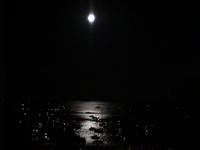 nd in crowds. As the feeling of inadequacy started creeping in, it got overpowered by my natural skills honed particularly by travelling in DTC buses. Out came an arm clutching my handbag under it, the zipped side firmly against my person, my unduly long plait in front of me rather than behind as it has a tendency of getting stuck in zippers (of bags all ye perverts) in the most painful manner. At long last the tram made its way through crowds in its way, to the stop itself. I could see people packed in like sardines. As luck would have it, the tram stopped with its doors right in front of me and I felt like I was drowning in a sea of scurrying (make that jostling) mice. I somehow made it into the tram, well versed with situations like this and held onto the first handrest I could get my hands on. I couldnt fathom just where all these ppl were going. It was unusually cr
nd in crowds. As the feeling of inadequacy started creeping in, it got overpowered by my natural skills honed particularly by travelling in DTC buses. Out came an arm clutching my handbag under it, the zipped side firmly against my person, my unduly long plait in front of me rather than behind as it has a tendency of getting stuck in zippers (of bags all ye perverts) in the most painful manner. At long last the tram made its way through crowds in its way, to the stop itself. I could see people packed in like sardines. As luck would have it, the tram stopped with its doors right in front of me and I felt like I was drowning in a sea of scurrying (make that jostling) mice. I somehow made it into the tram, well versed with situations like this and held onto the first handrest I could get my hands on. I couldnt fathom just where all these ppl were going. It was unusually cr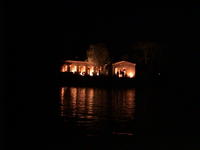 owded even for a weekend, and then I realised that they were all headed to watch the fireworks near the harbour. Unfortunately I had the daunting task of getting off somewhere in between and not at the destination, where I would have just flowed out with the rest of the human mass. Experience has taught me to start making my way much before the stop arrives and that’s what I did. After getting together with some of my colleagues, we all started walking in the direction that we saw the crowds going in.
owded even for a weekend, and then I realised that they were all headed to watch the fireworks near the harbour. Unfortunately I had the daunting task of getting off somewhere in between and not at the destination, where I would have just flowed out with the rest of the human mass. Experience has taught me to start making my way much before the stop arrives and that’s what I did. After getting together with some of my colleagues, we all started walking in the direction that we saw the crowds going in.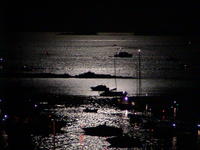 e fireworks explosion. The crowd gasped collectively. “Poor mites”, I thought as I remembered the diwali crackers back home and concentrated more on the huge thaali sized full moon, not so readily available back home. After enjoying the fireworks display, we enjoyed the huge moon and the glistening ocean, by sitting atop a hill in Kaivopuisto Park, far away from streetlights. No photography can justify the beauty of that moment.
e fireworks explosion. The crowd gasped collectively. “Poor mites”, I thought as I remembered the diwali crackers back home and concentrated more on the huge thaali sized full moon, not so readily available back home. After enjoying the fireworks display, we enjoyed the huge moon and the glistening ocean, by sitting atop a hill in Kaivopuisto Park, far away from streetlights. No photography can justify the beauty of that moment.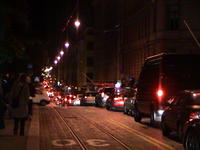 e it to the station, just in time to catch the 12:45am bus. There was a long queue for the bus, full of people acting stupid and drunk. I stood a little distance away from the queue, also wondering how I would ever secure a seat for myself for a 45 minute journey when everyone seemed to be going in that very bus. The bus arrived shortly and for the second time that day, it stopped right where I was standing and the doors opened right infront of me. Amused to the core, I stepped in, before another jostling session would have pushed me in.
e it to the station, just in time to catch the 12:45am bus. There was a long queue for the bus, full of people acting stupid and drunk. I stood a little distance away from the queue, also wondering how I would ever secure a seat for myself for a 45 minute journey when everyone seemed to be going in that very bus. The bus arrived shortly and for the second time that day, it stopped right where I was standing and the doors opened right infront of me. Amused to the core, I stepped in, before another jostling session would have pushed me in.

 (loosely translated to bicycle ride). It had the main character (written in first person) rather scared of riding a bicycle if I remember correctly. One fine day, he did muster enough courage to get on with it and his fears became reality. He fell down and broke his spectacles (without which he was almost blind) along with probably some other parts of his body. I may be mixing it up with another story. I don’t remember much of it except that it struck as pretty funny and well written then and full of rather wry humour. I remember his apprehension and his admission that it was unfounded and his still not being able to do anything about it and the amused style in which the narrator saw things. The term ‘cykil kee sawaari’ became synonymous with that feeling.
(loosely translated to bicycle ride). It had the main character (written in first person) rather scared of riding a bicycle if I remember correctly. One fine day, he did muster enough courage to get on with it and his fears became reality. He fell down and broke his spectacles (without which he was almost blind) along with probably some other parts of his body. I may be mixing it up with another story. I don’t remember much of it except that it struck as pretty funny and well written then and full of rather wry humour. I remember his apprehension and his admission that it was unfounded and his still not being able to do anything about it and the amused style in which the narrator saw things. The term ‘cykil kee sawaari’ became synonymous with that feeling.